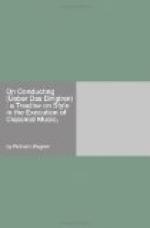victim! Safely bedded in this wise, not only the
overture, but, as will appear in the sequel, the entire
opera of Die Meistersinger, or as much of it as was
left after the Capellmeister’s cuts, was presented
to the public of Dresden. On this occasion, correctly
and technically speaking, the merits of the conductor
[Footnote: The late Julius Rietz.] consisted in
this: he made a guess at the main tempo, chose
the broadest nuance of it, and spread this over the
whole, beating the steadiest and stiffest square time
from beginning to end! The ultimate results were
as follows: I had made use of the combination
of the two main themes under an ideal Tempo Andante
alia breve (quoted above from the conclusion of the
overture, page 94) to form a pleasant and cheerful
conclusion to the entire opera, something after the
manner of a burden to some old popular song:
I had augmented and enlarged the treatment of the thematic
combination for this purpose, and now employed it as
a sort of accompaniment to Hans Sachs’s epilogising
praise of the “Master-singers,” and to
his consolatory rhymes upon German art, with which
the work ends. Though the words are serious, the
closing apostrophe is none the less meant to have
a cheering and hopeful effect; and, to produce this,
I counted upon that simple thematic combination, the
rhythmical movement of which was intended to proceed
smoothly, and was not meant to assume a pompous character,
except just before the end, when the chorus enters.
Now in the overture, the conductor had failed to see
the necessity of a modification of the original march-like
tempo in the direction of an Andante alla breve; and,
of course, here—at the close of the opera—he
equally failed to feel that the movement was not directly
connected with the march tempo—his first
mistake was therefore continued, and he proceeded to
confine and hold fast the warmly-feeling singer of
the part of Hans Sachs in rigid 4/4 time, and to compel
him to deliver his final address in the stiffest and
most awkward manner possible. Friends of mine
requested me to permit a large “cut” for
Dresden, as the effect of the close was so very depressing.
I declined; and the complaints soon ceased. At
length I came to understand the reason why; the Capellmeister
had acted for the obstinate composer; “solely
with a view to the good of the work,” he had
followed the dictates of his artistic insight and conscience,
had laid his hands on the troublesome apostrophe,
and simply “Cut” it.
“Cut! Cut!”—this is the ultimo ratio of our conductors; by its aid they establish a satisfactory equilibrium between their own incompetence, and the proper execution of the artistic tasks before them. They remember the proverb: “What I know not, burns me not!” ("was ich nicht weiss, macht mich nicht heiss”) and the public cannot object to an arrangement so eminently practical. It only remains for me to consider what I am to say to a performance of my work, which thus appears enclosed




